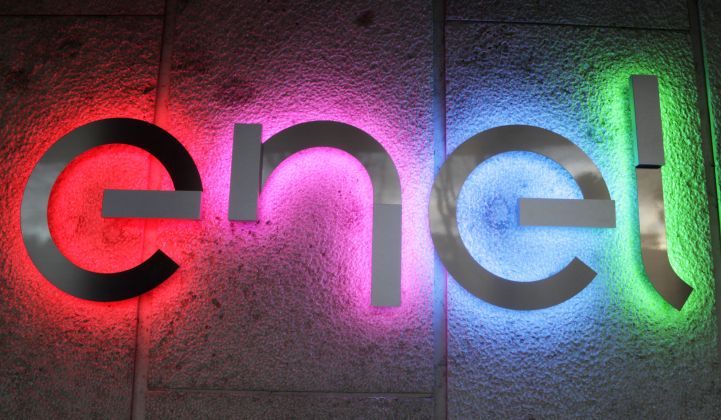Enel, the Italian multinational energy firm, is expecting its new e-solutions brand to launch with an "impressive contribution" to the utility's earnings.
The subsidiary, Enel X, is expected to see fourfold growth in its contribution to EBITDA over its first three years, rising from €100 million (USD $117 million) next year to €400 million ($469 million) by 2020, Enel X’s head, Francesco Venturini, told GTM.
Enel X is a rebranding of an e-solutions division launched earlier this year.
It will encompass Enel’s recent American acquisitions, including Demand Energy, EnerNOC and eMotorWerks, and will sit alongside current subsidiaries including the renewable energy company Enel Green Power and country brands such as Endesa in Spain.
The launch will likely imply some internal reshuffling of teams. Demand Energy, for example, is expected to fold into EnerNOC, which itself was bought through Enel Green Power North America and thus will have to transition out of its current business division.
Enel X will provide commercial and industrial power flexibility services, electric mobility applications, support for home energy appliances, and public administration offerings, including wholesale fiber optic provision.
Enel's leap into telecommunications and consumer electronics territory underscores the company's seriousness about the energy transition.
“The new global business line is a key component of the group's strategy to lead the ongoing energy transition, which is reshaping the role of utilities,” said Venturini.
“This transformation is driven by the unstoppable growth of renewables, the push toward digitalization, and the fight against climate change, which calls for energy efficiency measures and the electrification not only of the energy sector but of other industry sectors too," he said.
Technological progress is propelling the market toward an “energy-cloud platform” model, he said, underscoring parallels between the electricity sector and the post-internet telecommunications sector.
“Customers have new needs as a result of the more active and mindful role they play in the energy landscape,” he commented. “In line with the Group's strategic plan, which has digitalization and customer focus among its pillars, e-solutions is called upon to make the most of the opportunities that arise from these challenges, implementing an energy-as-a-service model.”
Further buyouts could be possible as Enel X looks to enlarge its portfolio of products and services, he said. “We will look for acquisitions in the geographies where we operate, if and where good opportunities may arise.”
In a column on Enel's recent acquisition activity, GTM Analyst Elta Kolo said the shopping spree "is just getting started, with large pockets of opportunity remaining to be filled in [Enel's] four focus areas."
Meredith Annex, European power and gas senior associate at Bloomberg New Energy Finance, said the subsidiary would help keep Enel at the vanguard of energy transition moves in Europe.
“Enel was one of the utilities that was at the forefront of pursuing services as a new area for growth,” she said, “but this is a trend we are seeing across the board with European utilities.”
E.ON and Engie have separate divisions focused on customer retail and services, she said. EDF Energy, meanwhile, is carrying out similar work through its Blue Lab innovation accelerator unit. Nevertheless, “the things Enel is working on are interesting,” said Annex.
“The fact they have this capacity to do fiber-optic networks is different from a lot of the other utilities in Europe,” she said. “It gives them a good opportunity in terms of networks, which is really the forefront of what Enel is pushing.”
In this respect, said Annex, the company has benefited from being able to rate-base smart meter rollouts, which is not possible for all European utilities. It gives Enel a ready-made platform for the delivery of digital services.
Adam Barber, managing director of Oxford, U.K.-based renewable energy consultancy The Tamarindo Group, said the initial impact of Enel X would be minimal as far as customers are concerned, but could be significant in terms of developing Enel’s strategy in Europe.
“This is all about Enel delivering against their next three- to five-year strategy and making sure they have effectively de-risked and started segmenting their business in line with a wider industry trend,” he said.



